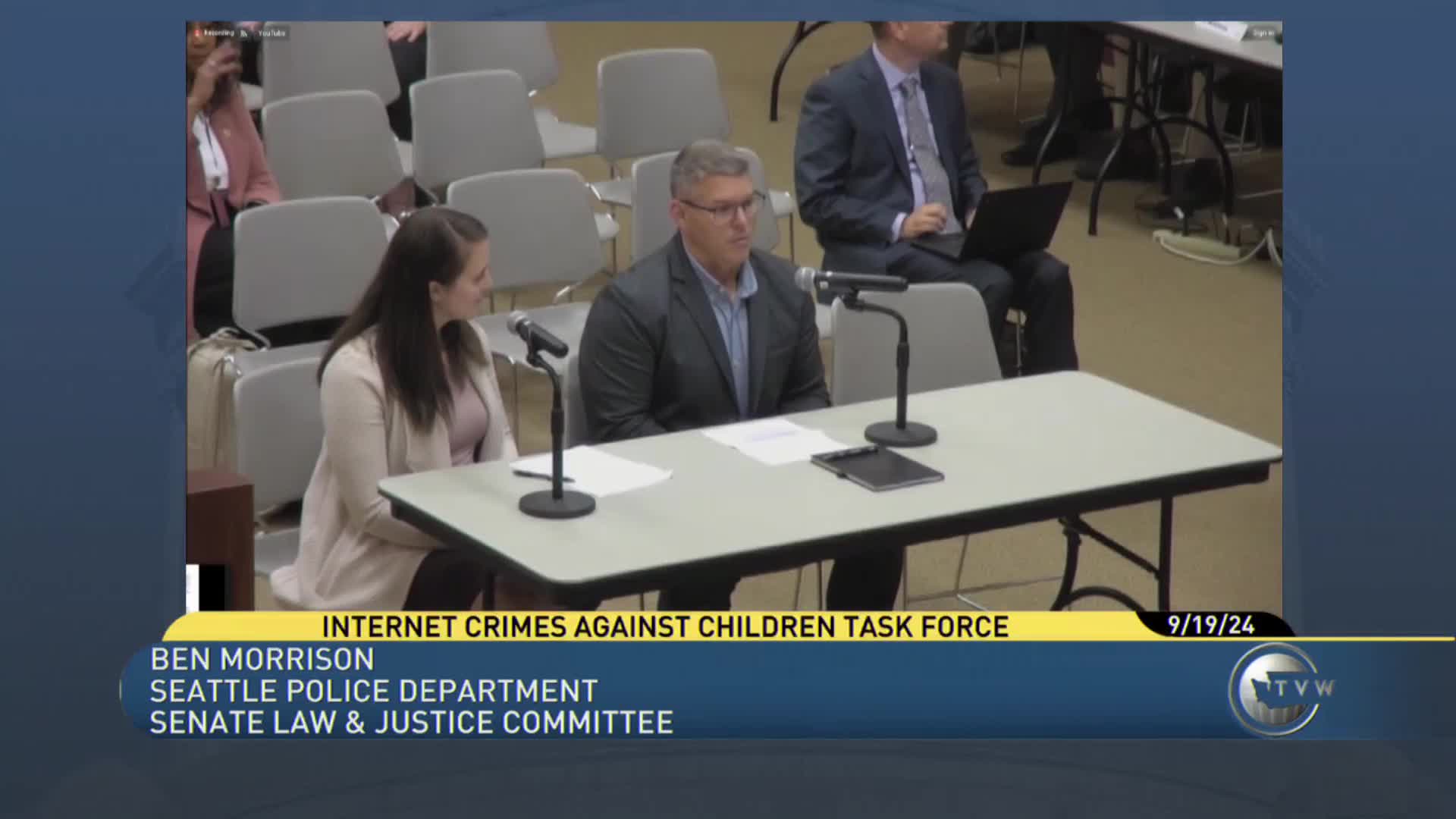Task force struggles with overwhelming backlog of child exploitation cases
September 19, 2024 | Law & Justice, Senate, Legislative Sessions, Washington
This article was created by AI summarizing key points discussed. AI makes mistakes, so for full details and context, please refer to the video of the full meeting. Please report any errors so we can fix them. Report an error »

In a recent government meeting, officials discussed the pressing challenges faced by law enforcement agencies in addressing Internet Crimes Against Children (ICAC). The Seattle Police Department (SPD), as the lead agency, reported a staggering influx of cyber tips—approximately 1,000 per month—related to potential child exploitation. This overwhelming volume, part of a national total of 36 million tips received by the National Center for Missing and Exploited Children, underscores the urgent need for resources and support in investigating these crimes.
The SPD highlighted its limited manpower, with only three full-time detectives dedicated to ICAC cases, which are complex and time-consuming. The department has provided over 4,000 hours of investigative assistance to affiliates outside Seattle this year alone, yet the backlog of cases remains a significant concern. Currently, there are 60 cases awaiting forensic analysis, which can involve sifting through vast amounts of data from multiple electronic devices seized during investigations.
Officials emphasized the need for enhanced funding and resources, noting that the average annual federal support of $500,000 for task forces has not kept pace with the growing number of cyber tips and the technological demands of investigations. The cost of necessary technology can exceed $100,000 per item, further straining budgets.
Additionally, the meeting addressed legislative gaps that hinder prosecutions. The current three-year statute of limitations for certain crimes, coupled with the increasing sophistication of digital security, complicates efforts to gather evidence. Law enforcement advocates are calling for an extension of this timeframe to ten years to better align with technological advancements.
The rise of artificial intelligence (AI) in creating potentially harmful digital content was also a focal point. Officials expressed concern over the lack of federal mandatory reporting for AI-generated images, which complicates the identification and prosecution of offenders. They noted that existing laws do not adequately address the nuances of AI-generated content, allowing some offenders to evade prosecution by claiming ignorance regarding the authenticity of the images.
Moreover, the meeting highlighted a loophole in the production statute that prevents prosecution in cases where minors are unaware they are being recorded. This gap in the law has significant implications for cases involving surreptitious recordings or exploitation of unconscious minors.
Finally, the discussion touched on the juvenile access to an attorney statute, which currently restricts law enforcement's ability to seek consent from juvenile victims or witnesses to search their devices. This limitation hampers investigations and the ability to protect vulnerable individuals from further exploitation.
As the meeting concluded, officials reiterated the critical need for legislative reforms and increased resources to effectively combat the growing threat of child exploitation in the digital age.
The SPD highlighted its limited manpower, with only three full-time detectives dedicated to ICAC cases, which are complex and time-consuming. The department has provided over 4,000 hours of investigative assistance to affiliates outside Seattle this year alone, yet the backlog of cases remains a significant concern. Currently, there are 60 cases awaiting forensic analysis, which can involve sifting through vast amounts of data from multiple electronic devices seized during investigations.
Officials emphasized the need for enhanced funding and resources, noting that the average annual federal support of $500,000 for task forces has not kept pace with the growing number of cyber tips and the technological demands of investigations. The cost of necessary technology can exceed $100,000 per item, further straining budgets.
Additionally, the meeting addressed legislative gaps that hinder prosecutions. The current three-year statute of limitations for certain crimes, coupled with the increasing sophistication of digital security, complicates efforts to gather evidence. Law enforcement advocates are calling for an extension of this timeframe to ten years to better align with technological advancements.
The rise of artificial intelligence (AI) in creating potentially harmful digital content was also a focal point. Officials expressed concern over the lack of federal mandatory reporting for AI-generated images, which complicates the identification and prosecution of offenders. They noted that existing laws do not adequately address the nuances of AI-generated content, allowing some offenders to evade prosecution by claiming ignorance regarding the authenticity of the images.
Moreover, the meeting highlighted a loophole in the production statute that prevents prosecution in cases where minors are unaware they are being recorded. This gap in the law has significant implications for cases involving surreptitious recordings or exploitation of unconscious minors.
Finally, the discussion touched on the juvenile access to an attorney statute, which currently restricts law enforcement's ability to seek consent from juvenile victims or witnesses to search their devices. This limitation hampers investigations and the ability to protect vulnerable individuals from further exploitation.
As the meeting concluded, officials reiterated the critical need for legislative reforms and increased resources to effectively combat the growing threat of child exploitation in the digital age.
View full meeting
This article is based on a recent meeting—watch the full video and explore the complete transcript for deeper insights into the discussion.
View full meeting
